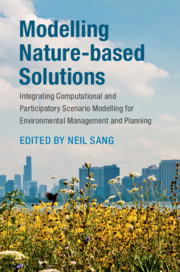 Modelling Nature-based Solutions
Modelling Nature-based Solutions Book contents
- Modelling Nature-based Solutions
- Modelling Nature-based Solutions
- Copyright page
- Contents
- Contributors
- Foreword
- Acknowledgements
- Introduction
- 1 Landscape Modelling and Stakeholder Engagement: Participatory Approaches and Landscape Visualisation
- 2 Agent-based Models of Coupled Social and Natural Systems
- 3 Modelling Nature-based Solutions from Soil Ecosystem Services
- 4 Modelling Water Resources for Nature-based Solutions
- 5 Models at the Service of Marine Nature-based Solutions
- 6 Coastal and Freshwater Flood Models: A Review in the Context of NBS
- 7 Nature-based Solutions to Urban Microclimate Regulation
- 8 Data Mining, Machine Learning and Spatial Data Infrastructures for Scenario Modelling
- 9 Can Geodesign Be Used to Facilitate Boundary Management for Planning and Implementation of Nature-based Solutions?
- 10 Integrating Models into Practice – Recommendations
- Appendix: List of Models/Software
- Index
- Plate Section (PDF Only)
- References
5 - Models at the Service of Marine Nature-based Solutions
Published online by Cambridge University Press: 13 March 2020
- Modelling Nature-based Solutions
- Modelling Nature-based Solutions
- Copyright page
- Contents
- Contributors
- Foreword
- Acknowledgements
- Introduction
- 1 Landscape Modelling and Stakeholder Engagement: Participatory Approaches and Landscape Visualisation
- 2 Agent-based Models of Coupled Social and Natural Systems
- 3 Modelling Nature-based Solutions from Soil Ecosystem Services
- 4 Modelling Water Resources for Nature-based Solutions
- 5 Models at the Service of Marine Nature-based Solutions
- 6 Coastal and Freshwater Flood Models: A Review in the Context of NBS
- 7 Nature-based Solutions to Urban Microclimate Regulation
- 8 Data Mining, Machine Learning and Spatial Data Infrastructures for Scenario Modelling
- 9 Can Geodesign Be Used to Facilitate Boundary Management for Planning and Implementation of Nature-based Solutions?
- 10 Integrating Models into Practice – Recommendations
- Appendix: List of Models/Software
- Index
- Plate Section (PDF Only)
- References
Summary
A broad marine management goal is to maintain healthy marine social–ecological systems that sustain desirable marine ecosystem services (MES) and have the capacity to adapt to change. Models, as representations of how systems work, are promising tools for understanding marine ecosystem and socio-economic processes (Addison et al. 2017; Zedler, 2017). Marine models can translate alternative scenarios exploring the projected consequences on marine ecosystem function of possible futures for drivers of change such as greenhouse gas (GhG) emissions, coastal development, and market, political and socio-cultural forces on seafood consumption (Millennium Ecosystem Assessment (MEA), 2005; Inniss et al. 2016; Intergovernmental Science-Policy Platform on Biodiversity and Ecosystem Services (IPBES), 2016; Katona et al. 2017). They can also help decision-makers to evaluate national or local scenarios examining the effectiveness of alternative past or future policy interventions influencing society’s demand for specific ES and their delivery to society (Guerry et al., 2012; IPBES, 2016; Arkema et al., 2017).
Information
- Type
- Chapter
- Information
- Modelling Nature-based SolutionsIntegrating Computational and Participatory Scenario Modelling for Environmental Management and Planning, pp. 152 - 209Publisher: Cambridge University PressPrint publication year: 2020